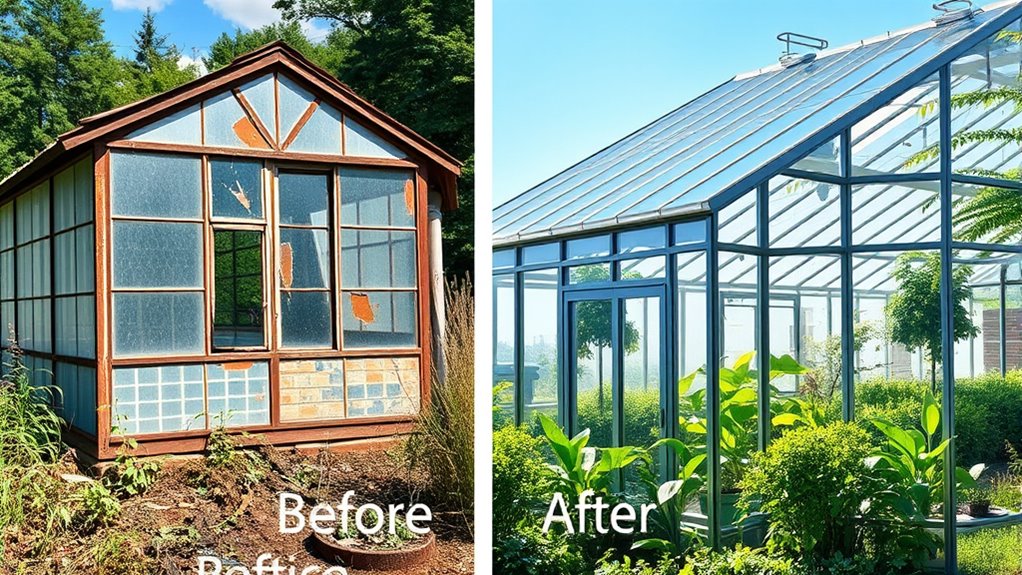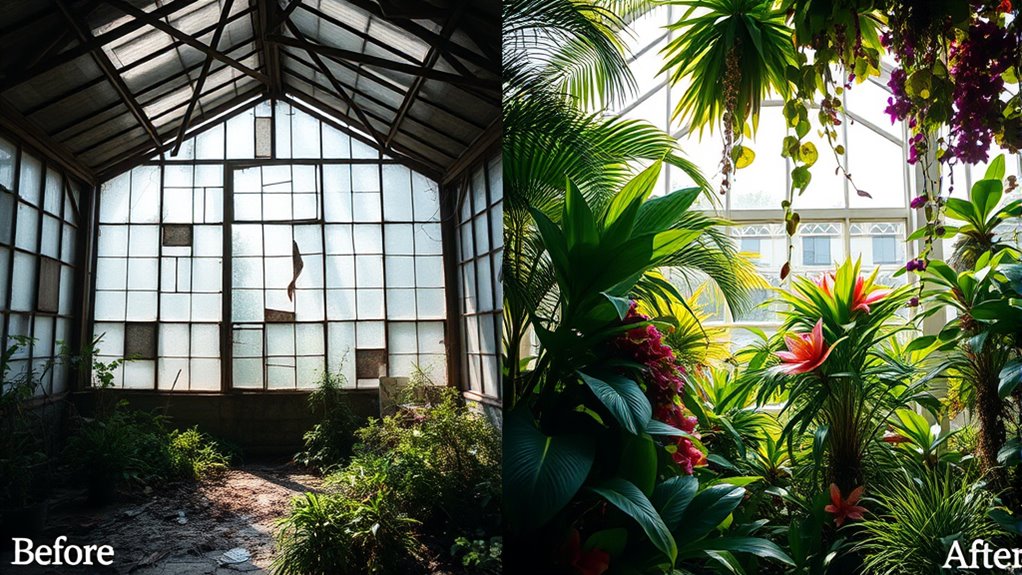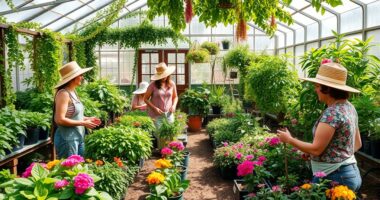Discover inspiring before-and-after stories of greenhouse makeovers that highlight eco-friendly upgrades and innovative design. You’ll see how people evaluate their existing structures, replacing old glazing with recycled or energy-efficient materials, and improve insulation to reduce energy use. They incorporate sustainable features like composting, rainwater harvesting, solar lighting, and reclaimed wood. These transformations create productive, beautiful spaces that promote environmental responsibility. Keep exploring to see how these DIY projects turn simple greenhouses into inspiring models of sustainability.
Key Takeaways
- Showcases dramatic visual improvements through eco-friendly renovations and sustainable material upgrades.
- Highlights innovative reuse of reclaimed wood, recycled materials, and DIY solutions for functional enhancements.
- Demonstrates energy efficiency gains via insulation, sealing, and renewable energy integrations like solar power.
- Emphasizes customization for specific gardening needs, optimizing space for vegetables, flowers, or relaxation.
- Reflects environmental benefits and personal satisfaction from transforming a basic structure into a sustainable sanctuary.

Have you ever wondered how a simple greenhouse can evolve into a thriving hub of innovation and sustainability? It’s incredible how much transformation is possible when you combine a passion for sustainable practices with a hands-on approach through DIY renovation. When you start, it might seem like just a basic structure, but with some creativity and effort, it becomes a centerpiece of eco-conscious living and growing.
A simple greenhouse can become an eco-friendly hub through DIY renovation and sustainable practices.
The first step in an inspiring greenhouse makeover is often a thorough assessment of what needs to change. You might find that the original materials are worn out or inefficient at maintaining temperature and humidity. Here, your focus on sustainable practices becomes essential. You can replace old glazing with recycled or energy-efficient materials, reducing your carbon footprint while improving insulation. Using reclaimed wood for framing or installing solar-powered fans and lighting further amplifies your eco-friendly approach. This process isn’t just about fixing what’s broken; it’s about rethinking the entire structure to maximize sustainability and functionality.
A DIY renovation gives you the power to tailor the space exactly to your needs, whether that’s a lush vegetable garden, a floral retreat, or a space for educational projects. You might decide to incorporate composting systems or rainwater harvesting setups, aligning with sustainable practices that minimize waste and conserve resources. Building these features yourself not only saves money but also deepens your connection to the space, making every improvement meaningful. Plus, the hands-on nature of a DIY project keeps you engaged and allows you to learn new skills along the way.
As you progress, you’ll see how small changes add up to a big impact. Installing reflective insulation, sealing gaps, and adding shading devices can drastically reduce energy use. If you’re handy, you might even craft your own storage shelves or plant trellises from recycled materials. The beauty of DIY renovation is that it’s flexible—you can adapt your plans as you learn what works best in your climate and for your plants. This level of customization makes the greenhouse not just a structure, but a reflection of your commitment to sustainable living.
Ultimately, transforming a basic greenhouse through DIY renovation and sustainable practices turns it into a vibrant, eco-friendly sanctuary. Each step you take, from upgrading materials to installing energy-efficient systems, contributes to a healthier planet and a more productive growing environment. The satisfaction of creating something with your own hands, knowing it’s environmentally responsible, makes the transformation even more rewarding. It’s proof that with effort and intention, a simple structure can become a shining example of sustainable innovation.
Frequently Asked Questions
What Are the Most Cost-Effective Greenhouse Renovation Options?
To find the most cost-effective greenhouse renovation options, start with budget-friendly upgrades like sealing leaks and adding insulation to reduce heating costs. Use cost-saving tips such as repainting or replacing glazing panels with affordable materials. Focus on small improvements that boost efficiency without overspending. You’ll save money while enhancing your greenhouse’s performance, making renovation both practical and budget-conscious. Remember, smart upgrades can deliver big results without breaking the bank.
How Long Does a Typical Greenhouse Transformation Process Take?
Imagine transforming your greenhouse into a lush paradise—how long does that take? With proper seasonal planning and effective ventilation strategies, a typical transformation can last anywhere from a few weeks to a couple of months. You’ll need time for design, materials, and installation, but staying organized speeds up the process. Keep your goals clear, and you’ll see your dream greenhouse bloom faster than you think.
What Are Common Mistakes to Avoid During a Greenhouse Upgrade?
When upgrading your greenhouse, avoid neglecting proper ventilation systems and lighting upgrades, as these are essential for plant health. Don’t overlook planning for adequate airflow, which prevents mold and pests. Also, make certain your lighting is suitable for your crops, avoiding overly bright or dim setups. Rushing the process or skipping professional advice can lead to costly mistakes. Take your time, research, and consult experts to guarantee a successful upgrade.
Which Plants Thrive Best After Greenhouse Improvements?
Ever wonder which plants thrive after a greenhouse upgrade? With your improved space, you’ll find that tropical plants, succulents, and herbs flourish best due to better conditions and controlled environments. Focus on smart plant selection and effective pest control to guarantee healthy growth. Choosing the right plants not only boosts your greenhouse’s beauty but also makes pest management easier, giving you a lush, thriving garden after your transformation.
How Can I Maintain My Greenhouse’s New Features Effectively?
To keep your greenhouse’s new features in top shape, you should regularly monitor climate control systems to guarantee ideal temperature and humidity. Keep pest management practices in check by inspecting plants frequently and using eco-friendly methods. Clean and maintain ventilation, heating, and watering equipment, and update your strategies seasonally. Consistent attention to these details will help your greenhouse stay healthy, productive, and thriving long after your improvements.
Conclusion
Your greenhouse journey proves that with a little vision and effort, you can turn a simple space into a lush oasis. Like a caterpillar transforming into a vibrant butterfly, your patience and dedication bring beauty to life. Each transformation story is a affirmation to the magic you hold within your hands. Keep dreaming, keep cultivating, and watch your green paradise flourish into something truly extraordinary—because your garden’s story is just beginning to bloom.







